Miele FN 12221 S, FN 12421 S, FN 12621 S, FN 12821 S Operating instructions
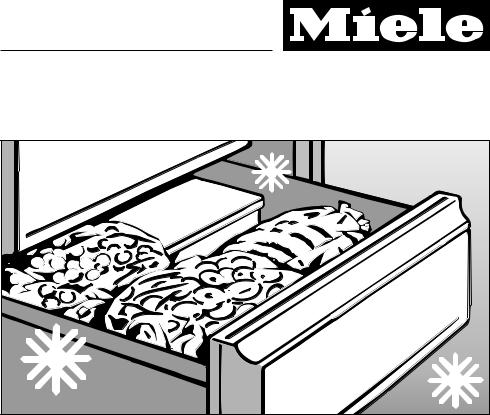
Operating and installation instructions
Frost-free freezer
FN 12221 S
FN 12421 S
FN 12621 S
FN 12821 S
To avoid the risk of accidents or |
en - GB |
damage to the appliance, it is |
|
essential to read these instructions |
|
before it is installed and used for the |
|
first time. |
M.-Nr. 09 290 850 |

Contents
Guide to the appliance . . . . . . . . . . . . . . . . . . . . . . . . . . . . . . . . . . . . . . . . . . . . . 4
Caring for the environment . . . . . . . . . . . . . . . . . . . . . . . . . . . . . . . . . . . . . . . . . . 6
Warning and Safety instructions . . . . . . . . . . . . . . . . . . . . . . . . . . . . . . . . . . . . . 7
How to save energy . . . . . . . . . . . . . . . . . . . . . . . . . . . . . . . . . . . . . . . . . . . . . . . 12
Switching on and off . . . . . . . . . . . . . . . . . . . . . . . . . . . . . . . . . . . . . . . . . . . . . . 13 Before using for the first time . . . . . . . . . . . . . . . . . . . . . . . . . . . . . . . . . . . . . . . . . 13 Switching on . . . . . . . . . . . . . . . . . . . . . . . . . . . . . . . . . . . . . . . . . . . . . . . . . . . . . 13 Switching off . . . . . . . . . . . . . . . . . . . . . . . . . . . . . . . . . . . . . . . . . . . . . . . . . . . . . 13 Switching off for longer periods of time . . . . . . . . . . . . . . . . . . . . . . . . . . . . . . . . . 13
Customising settings . . . . . . . . . . . . . . . . . . . . . . . . . . . . . . . . . . . . . . . . . . . . . 14 Settings mode . . . . . . . . . . . . . . . . . . . . . . . . . . . . . . . . . . . . . . . . . . . . . . . . . 14 Altering the brightness of the display . . . . . . . . . . . . . . . . . . . . . . . . . . . . . . . . 14 Activating or deactivating the safety lock. . . . . . . . . . . . . . . . . . . . . . . . . . . . . 15
The correct temperature . . . . . . . . . . . . . . . . . . . . . . . . . . . . . . . . . . . . . . . . . . . 17 Setting the temperature . . . . . . . . . . . . . . . . . . . . . . . . . . . . . . . . . . . . . . . . . . . . . 17 Temperature display . . . . . . . . . . . . . . . . . . . . . . . . . . . . . . . . . . . . . . . . . . . . . . . 18
Alarm. . . . . . . . . . . . . . . . . . . . . . . . . . . . . . . . . . . . . . . . . . . . . . . . . . . . . . . . . . . 19 Temperature alarm . . . . . . . . . . . . . . . . . . . . . . . . . . . . . . . . . . . . . . . . . . . . . . . . 19 Door alarm . . . . . . . . . . . . . . . . . . . . . . . . . . . . . . . . . . . . . . . . . . . . . . . . . . . . . . . 19 Switching the alarm off early . . . . . . . . . . . . . . . . . . . . . . . . . . . . . . . . . . . . . . . . . 19
Super freeze . . . . . . . . . . . . . . . . . . . . . . . . . . . . . . . . . . . . . . . . . . . . . . . . . . . . . 20
Freezing and storing food . . . . . . . . . . . . . . . . . . . . . . . . . . . . . . . . . . . . . . . . . . 21 Maximum freezing capacity. . . . . . . . . . . . . . . . . . . . . . . . . . . . . . . . . . . . . . . . . . 21 Freezing fresh food . . . . . . . . . . . . . . . . . . . . . . . . . . . . . . . . . . . . . . . . . . . . . . . . 21 Isolation plate. . . . . . . . . . . . . . . . . . . . . . . . . . . . . . . . . . . . . . . . . . . . . . . . . . . . . 21 Important. . . . . . . . . . . . . . . . . . . . . . . . . . . . . . . . . . . . . . . . . . . . . . . . . . . . . . 21 Storing frozen food . . . . . . . . . . . . . . . . . . . . . . . . . . . . . . . . . . . . . . . . . . . . . . . . 22 Home freezing . . . . . . . . . . . . . . . . . . . . . . . . . . . . . . . . . . . . . . . . . . . . . . . . . . . . 23 Hints on home freezing. . . . . . . . . . . . . . . . . . . . . . . . . . . . . . . . . . . . . . . . . . . 23 Packaging . . . . . . . . . . . . . . . . . . . . . . . . . . . . . . . . . . . . . . . . . . . . . . . . . . . . 23 Before placing food in the freezer compartment . . . . . . . . . . . . . . . . . . . . . . . 24 Placing food in the freezer compartment . . . . . . . . . . . . . . . . . . . . . . . . . . . . . 24 Defrosting . . . . . . . . . . . . . . . . . . . . . . . . . . . . . . . . . . . . . . . . . . . . . . . . . . . . . . . 25 Ice cubes . . . . . . . . . . . . . . . . . . . . . . . . . . . . . . . . . . . . . . . . . . . . . . . . . . . . . . . . 25 Cooling drinks . . . . . . . . . . . . . . . . . . . . . . . . . . . . . . . . . . . . . . . . . . . . . . . . . . . . 25 Freezer tray . . . . . . . . . . . . . . . . . . . . . . . . . . . . . . . . . . . . . . . . . . . . . . . . . . . . . . 26
2

Contents
Defrosting . . . . . . . . . . . . . . . . . . . . . . . . . . . . . . . . . . . . . . . . . . . . . . . . . . . . . . . 27
Cleaning and care . . . . . . . . . . . . . . . . . . . . . . . . . . . . . . . . . . . . . . . . . . . . . . . . 28 Cleaning the interior and accessories . . . . . . . . . . . . . . . . . . . . . . . . . . . . . . . . . . 28 Appliance door, side panels . . . . . . . . . . . . . . . . . . . . . . . . . . . . . . . . . . . . . . . . . 29 Ventilation gaps . . . . . . . . . . . . . . . . . . . . . . . . . . . . . . . . . . . . . . . . . . . . . . . . . . . 29 Door seal . . . . . . . . . . . . . . . . . . . . . . . . . . . . . . . . . . . . . . . . . . . . . . . . . . . . . . . . 29 Metal grille at the back of the appliance . . . . . . . . . . . . . . . . . . . . . . . . . . . . . . . . 29
Problem solving guide . . . . . . . . . . . . . . . . . . . . . . . . . . . . . . . . . . . . . . . . . . . . 30
Noises . . . . . . . . . . . . . . . . . . . . . . . . . . . . . . . . . . . . . . . . . . . . . . . . . . . . . . . . . 34
After Sales / Guarantee . . . . . . . . . . . . . . . . . . . . . . . . . . . . . . . . . . . . . . . . . . . . 35
Information for dealers . . . . . . . . . . . . . . . . . . . . . . . . . . . . . . . . . . . . . . . . . . . . 36 Demo mode . . . . . . . . . . . . . . . . . . . . . . . . . . . . . . . . . . . . . . . . . . . . . . . . . . . . . 36
Electrical connection. . . . . . . . . . . . . . . . . . . . . . . . . . . . . . . . . . . . . . . . . . . . . . 37
Installation . . . . . . . . . . . . . . . . . . . . . . . . . . . . . . . . . . . . . . . . . . . . . . . . . . . . . . 38 Location . . . . . . . . . . . . . . . . . . . . . . . . . . . . . . . . . . . . . . . . . . . . . . . . . . . . . . . . . 38 Climate range . . . . . . . . . . . . . . . . . . . . . . . . . . . . . . . . . . . . . . . . . . . . . . . . . . 38 Ventilation . . . . . . . . . . . . . . . . . . . . . . . . . . . . . . . . . . . . . . . . . . . . . . . . . . . . . . . 38 Installation . . . . . . . . . . . . . . . . . . . . . . . . . . . . . . . . . . . . . . . . . . . . . . . . . . . . . . . 38 Aligning the appliance . . . . . . . . . . . . . . . . . . . . . . . . . . . . . . . . . . . . . . . . . . . . . . 39 Appliance dimensions . . . . . . . . . . . . . . . . . . . . . . . . . . . . . . . . . . . . . . . . . . . . . . 40
Changing the door hinging . . . . . . . . . . . . . . . . . . . . . . . . . . . . . . . . . . . . . . . . . 41
Aligning the appliance door . . . . . . . . . . . . . . . . . . . . . . . . . . . . . . . . . . . . . . . . 46
Building in the appliance . . . . . . . . . . . . . . . . . . . . . . . . . . . . . . . . . . . . . . . . . . 47
3
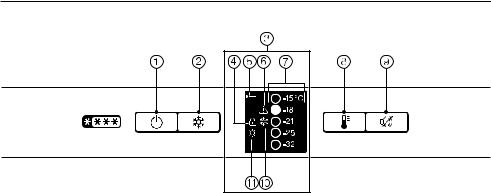
Guide to the appliance
aOn/Off button
bSuper freeze button
cDisplay
If the appliance is not operated for some time, the display will revert automatically to the brightness level which has been set.
As soon as a button is pressed the display will light up at the brightest setting.
dLock symbol
eMenu symbol Setting mode for:
–the brightness level of the display
–switching the lock on/off
fAlarm symbol
gTemperature display
hTemperature selector button
iAlarm off button
jSuper freeze symbol
kBrightness symbol
4
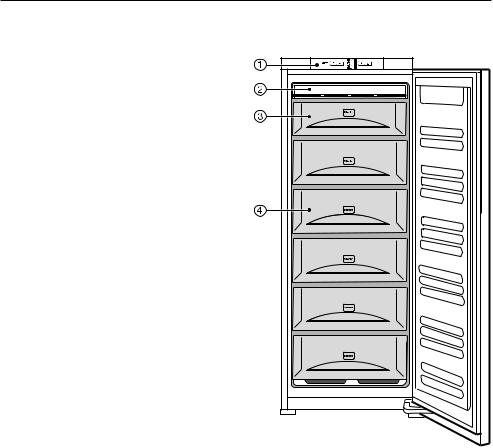
Guide to the appliance
aControl panel
bFrost-free system
cTop freezer drawer,
can be used as a freezer tray
dFreezer drawers (number will depend on model)
5
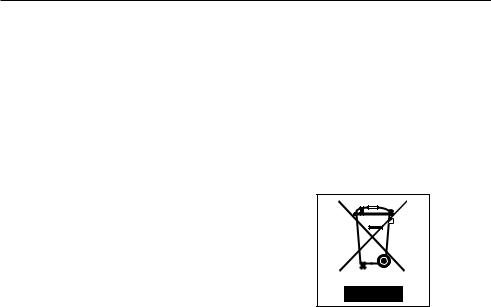
Caring for the environment
Disposal of the packing material
The transport and protective packing has been selected from materials which are environmentally friendly for disposal, and should be recycled.
Ensure that any plastic wrappings, bags etc. are disposed of safely and kept out of the reach of babies and young children. Danger of suffocation!
Disposal of your old appliance
Electrical and electronic appliances often contain materials which, if handled or disposed of incorrectly, could be potentially hazardous to human health and to the environment. They are, however, essential for the correct functioning of your appliance. Please do not therefore dispose of it with your household waste.
Please dispose of it at your local community waste collection / recycling centre or contact your dealer for advice. Ensure that it presents no danger to children while being stored for disposal.
Take care not to damage the pipework at the back of it before or during transportation to an authorised collection depot.
In this way, refrigerant in the pipework and oil in the compressor will be contained, and will not leak out into the environment.
6

Warning and Safety instructions
This appliance complies with all relevant safety requirements. Improper use can, however, present a risk of both personal injury and material damage.
To avoid the risk of accidents and damage to the appliance, please read these instructions carefully before installation and before using it for the first time. They contain important notes on installation, safety, operation and maintenance.
Keep these instructions in a safe place and pass them on to any future user.
Correct application
~ This appliance is not designed for commercial use. It is intended for use in domestic households and in similar working and residential environments such as:
–Shops
–Offices and showrooms
and by residents in establishments such as:
–Hostels and guest houses.
The appliance is not intended for outdoor use.
It must only be used as a domestic appliance to store deep frozen food, to freeze fresh food and to prepare ice.
Any other usage is not supported by the manufacturer and could be dangerous. Miele cannot be held liable for damage resulting from incorrect or improper use or operation of the appliance.
~ The appliance can only be used by people with reduced physical, sensory or mental capabilities, or lack of experience and knowledge, if they are supervised whilst using it, or have been shown how to use it in a safe way and understand the hazards involved.
Safety with children
~Children 8 years and older may use the appliance only if they have been shown how to use it in a safe way and understand the hazards involved.
~Children under 8 years of age must be kept away from the appliance unless they are constantly supervised.
~This appliance is not a toy! To prevent the risk of injury, do not allow children to play with it or near it or to play with the controls, or to swing on the door.
7
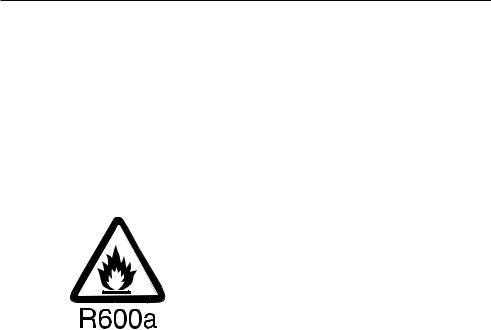
Warning and Safety instructions
Technical safety
~Before setting up the appliance, check it for any externally visible damage. Do not install and use a damaged appliance.
It could be dangerous.
~If the connection cable is faulty it must only be replaced by a service technician authorised by the manufacturer to protect the user from danger.
~ This appliance contains the coolant Isobutane (R600a), a natural gas which is environmentally friendly. Although it is flammable, it does not damage the ozone layer and does not increase the greenhouse effect. The use of this coolant has, however, led to a slight increase in the noise level of the appliance. In addition to the noise of the compressor, you might be able to hear the coolant flowing around the system. This is unavoidable, but does not have any adverse effect on the performance of the appliance.
Care must be taken during the transportation and installation of the appliance that no parts of the cooling system are damaged. Leaking coolant can damage the eyes.
In the event of any damage:
- avoid open flames and anything which creates a spark,
-disconnect from the mains,
-air the room in which the appliance is located for several minutes and
-contact the Service Department for advice.
~The more coolant there is in an appliance, the larger the room it should be installed in. In the event of a leakage, if the appliance is in a small room, there is the danger of
combustible gases building up.
For every 8 g of coolant at least 1 m3 of room space is required. The amount of coolant in the appliance is stated on the data plate inside the appliance.
~Safe operation of the appliance is only assured if it has been installed and connected in accordance with these operating and installation instructions.
~Before connecting the appliance to the mains supply, make sure that the connection data on the data plate corresponds to the voltage and frequency of the household supply. This data must correspond in order to avoid the risk of damage to the appliance. Consult a qualified electrician if in any doubt.
~Do not connect the appliance to the mains electricity supply by a multi-socket adapter or an extension lead. These do not guarantee the required safety of the appliance (e.g. danger of overheating).
8

Warning and Safety instructions
~The electrical safety of this appliance can only be guaranteed if correctly earthed. It is most important that this basic safety requirement is observed and regularly tested and where there is any doubt, the household wiring system should be inspected by a qualified electrician. The manufacturer cannot be held liable for damage or injury caused by the lack of or inadequacy of an effective earthing system (e.g. electric shock).
~Installation, maintenance and repairs may only be carried out by a suitably qualified and competent person in strict accordance with current national and local safety regulations. Repairs and other work by unqualified persons could be dangerous. The manufacturer cannot be held liable for unauthorised work.
~While the appliance is under guarantee, repairs should only be undertaken by a service technician authorised by the manufacturer. Otherwise the guarantee will be invalidated.
~The appliance must be isolated from the electricity supply during installation, maintenance and repair work.
~Faulty components must only be replaced by genuine Miele original spare parts. The manufacturer can only guarantee the safety of the appliance when Miele replacement parts are used.
~This appliance must not be used in a non-stationary location (e.g. on a ship).
~In areas which may be subject to infestation by cockroaches or other vermin, pay particular attention to keeping the appliance and its surroundings in a clean condition at all times. Any damage which may be caused by cockroaches or other vermin will not be covered by the guarantee.
9

Warning and Safety instructions
Correct use
~This appliance is designed for use within certain climate ranges (ambient temperatures), and should not be used outside this range. The climate range for your appliance is stated on the data plate inside the appliance.
Installing it in a room with too low an ambient temperature, e.g. a garage, can lead to the appliance switching off for longer periods so that it cannot maintain the required temperature.
~Do not block the ventilation gaps in the appliance as this would impair the efficiency of the appliance, increase the electricity consumption and could cause damage to the appliance.
~Never handle frozen food with wet hands. Your hands may freeze to the frozen food. Danger of frost burn.
~Do not take ice cubes out with your bare hands and never place ice cubes or ice lollies in your mouth straight from the freezer.
The very low temperature of the frozen ice or lollies can cause frost burn to the lips and tongue.
~Do not refreeze thawed or partially thawed food.
Defrosted food should be used up as quickly as possible, as food soon loses its nutritional value and goes off. Defrosted food may only be re-frozen after it has been cooked.
~Do not store cans or bottles containing carbonated drinks or liquids which could freeze in the freezer. The cans or bottles could explode.
Danger of injury and damage to the appliance.
~When cooling drinks quickly in the freezer, make sure bottles are not left in for more than one hour, otherwise they could burst. Danger of injury and damage.
~Observe the "use by" dates given on food to avoid the risk of food poisoning. Storage times will depend on several factors, including the freshness and quality of the food as well as the temperature at which it is stored. Follow the instructions given on food manufacturer's packaging on storage conditions required, as well as the "use by" date.
~Do not store explosive materials in the appliance or any products containing propellants (e.g. spray cans). Thermostats switching on may produce sparks which could present a fire hazard. Flammable compounds could explode.
10

Warning and Safety instructions
~Do not operate any electrical equipment (e.g. an electric ice-cream maker) inside the appliance. Danger of sparking and explosion.
~Do not use sharp edged objects to
– remove frost and ice,
–separate frozen foods or remove ice trays.
They will damage the evaporator, causing irreversible damage to the appliance.
~Never place electric heaters or candles in the appliance to defrost it. These can damage the plastic parts.
~Do not use defrosting sprays or de-icers, as they might contain substances which could damage the plastic parts or which could cause a build-up of gases and pose a danger to health.
~Do not use a steam-cleaning appliance to defrost or clean this appliance. Steam could reach electrical components and cause a short circuit.
~Do not use any oils or grease on the door seal, as these will cause the seal to deteriorate and become porous with time.
Disposal of your old appliance
~Before disposing of an old appliance, first make the door latch or lock unusable.
This way you will prevent children from accidentally locking themselves in and endangering their lives.
~Be careful not to damage any part of the pipework whilst awaiting disposal, e.g. by
–puncturing the refrigerant channels in the evaporator.
–bending any pipework.
–scratching the surface coating.
Splashes of refrigerant can damage the eyes.
The manufacturer cannot be held liable for damage caused by non-compliance with these Warning and Safety instructions.
11

How to save energy
|
Normal energy |
Increased energy |
|
|
consumption |
consumption |
|
|
|
|
|
Installation site |
In a ventilated room. |
In an enclosed, unventilated room. |
|
|
Protected from direct sunlight. |
In direct sunlight. |
|
|
Not near to a heat source (radiator, |
Near to a heat source (radiator, |
|
|
oven). |
oven). |
|
|
Where the ideal ambient room |
Where there is a high ambient room |
|
|
temperature is approx. 20°C. |
temperature. |
|
|
Do not cover the ventilation gaps |
|
|
|
and dust them regularly. |
|
|
|
|
|
|
Temperature setting |
With a medium setting of 2 to 3. |
With a high setting: the lower the |
|
with a thermostat |
|
temperature in the compartment, the |
|
which is approximate |
|
higher the energy consumption. |
|
(set in stages). |
|
|
|
|
|
|
|
Temperature setting |
Larder section 8 to 12 °C |
|
|
with a thermostat which |
Refrigerator section 4 to 5 °C |
On appliances with winter setting, |
|
is exact to the degree |
|
please make sure that the winter |
|
PerfectFresh zone just above 0 °C |
|||
(digital display). |
setting is switched off when the |
||
|
Freezer section -18 °C |
ambient temperature is warmer than |
|
|
16 °C . |
||
|
Wine storage section 10 to 12 °C |
||
|
|
||
|
|
|
|
Use |
Drawers, shelves and racks |
|
|
|
arranged as they were when the |
|
|
|
appliance was delivered. |
|
|
|
Only open the door when necessary |
Frequent opening of the door for |
|
|
and for as short a time as possible. |
long periods will cause a loss of |
|
|
|
coldness. |
|
|
Store food in an organised way. |
Searching for an item will mean the |
|
|
|
door is open for longer. |
|
|
Allow hot food and drinks to cool |
Hot food will cause the compressor |
|
|
down before placing them in the |
to run for a long time, as the |
|
|
appliance. |
appliance will have to work harder |
|
|
|
to reduce the temperature. |
|
|
Store food covered or packaged. |
The evaporation or condensation of |
|
|
|
liquids will cause a loss of coldness |
|
|
|
in the refrigerator. |
|
|
Place frozen food in the refrigerator |
|
|
|
to defrost. |
|
|
|
Do not over-fill the appliance to |
|
|
|
allow air to circulate. |
|
|
|
|
|
|
Defrosting |
Defrost the freezer section when a |
A layer of ice hinders the cold from |
|
|
layer of ice 0.5 cm thick (maximum) |
reaching the frozen food, and |
|
|
has built up. |
increases energy consumption. |
12
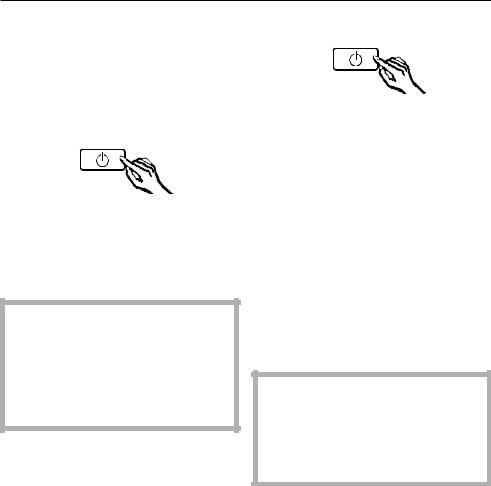
Switching on and off
Before using for the first time
^Clean the inside of the appliance and the accessories with lukewarm water and a little washing-up liquid, and then dry with a soft cloth.
Switching on
^ Press the On/Off button.
The temperature display and the alarm symbol will flash until the temperature in the freezer is cold enough.
To enable the temperature to get sufficiently cold inside the appliance, allow it to run for a few hours before placing food in it.
Do not place food in the appliance until the temperature is at least -18°C.
Switching off
^Press the On/Off button until the display goes out.
The cooling system is switched off.
Switching off for longer periods of time
If the appliance is not going to be used for a longer period of time, e.g. whilst on holiday:
^switch the appliance off,
^disconnect it from the mains,
^clean the appliance out and
^leave the door ajar to air it.
If, during a long absence, the appliance is switched off but not cleaned out and the door is left shut, there is a danger of mould and odours building up inside the appliance.
13
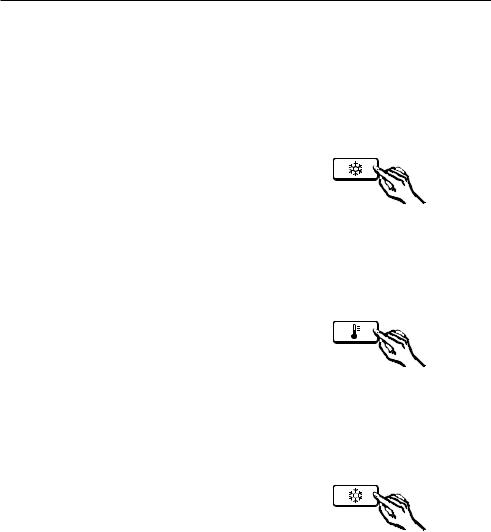
Customising settings
Settings mode
Certain settings on the appliance can be changed using Settings mode.
–The Lock can be activated and deactivated
–The brightness of the display can be altered
Settings mode is represented in the display by the Menu symbol . The following section describes how to access Settings mode and alter settings.
Altering the brightness of the display
The display brightness can be adjusted to suit the lighting conditions of the room.
There are five different display brightness settings. The factory default setting is 1.
^Press the Super freeze button for approx. five seconds.
The Menu symbol will light up; Settings mode is now activated. The Lock symbol will start flashing.
^Press the temperature selector button to call up the Brightness function.
The Lock symbol will go out and the Brightness symbol will start flashing.
^Press the Super freeze button briefly to confirm this.
The Brightness symbol will light up.
14

Customising settings
^Press the Temperature button repeatedly until the brightness level required is reached.
The more fields of the temperature display which light up, the brighter the display.
To confirm the altered setting:
^ Press the Super freeze button briefly.
The Brightness symbol will flash. The newly selected setting has been saved.
To come out of Settings mode:
^Press the On/Off button.
or
^Wait for 5 minutes.
The Menu and Brightness symbols will go out.
The temperature display will show the required temperature.
Activating or deactivating the Lock
The Lock can be activated to prevent the appliance being switched off by mistake.
– To activate the Lock
^Press the Super freeze button for approx. five seconds.
The Menu symbol will light up; Settings mode is now activated. The Lock symbol will start flashing.
^Press the Super freeze button briefly to call up the Lock function.
The Lock symbol will light up. The -15 °C and -21 °C fields will light up in the temperature display.
^Press the Super freeze button briefly to switch the Lock function on.
The Lock symbol will start flashing.
The -15 °C and -21 °C fields in the temperature display will go out.
15
